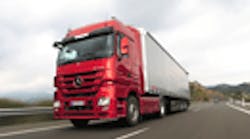Representatives of the European Union’s (EU) Parliament and Council have reached agreement on a plan that will allow member states to charge trucks additional levies for “external costs” and vary tariffs as a way to ease congestion during peak hours. The key to the deal, lawmakers said, is the earmarking of revenues from the fees for transportation infrastructure projects.
“We now have a strong commitment from the member states to reinvest the money in sustainable transport and spend at least 15% on TEN-T [Transeuropean Transport Network] projects,” said El Khadraoui (S&D, BE).
Under the deal, which still must be ratified by the full Parliament and Council, member states will be able to charge “extra mark-ups” for older trucks (Euro class 0-3), particularly in mountainous regions, and all of that revenue collected will have to be spent on financing so-called Ten-T infrastructure projects on the same TEN corridor.
“This is not the end of the road,” said Mr El Khadraoui, “but it’s an important step forward. I hope that Parliament can support the deal so that member states can make the best use of the directive.”
Parliament's plenary vote is scheduled on June 7.
Also designed as a way to encourage the purchase of more fuel-efficient, less-polluting trucks, and to ease traffic congestion, the program allows for the collection of additional revenues and tolls of up to 175% in congested areas during peak hours, with a 5-hour maximum window each day. Lower tariffs would be allowed the rest of the day as a way to better manage traffic without generating additional revenues, the organization said.
The agreement also calls for transparency in the program, mandating that all member states report back to the commission on a regular basis the types of toll income it is collecting, the variations applied, and how the money has been invested.



